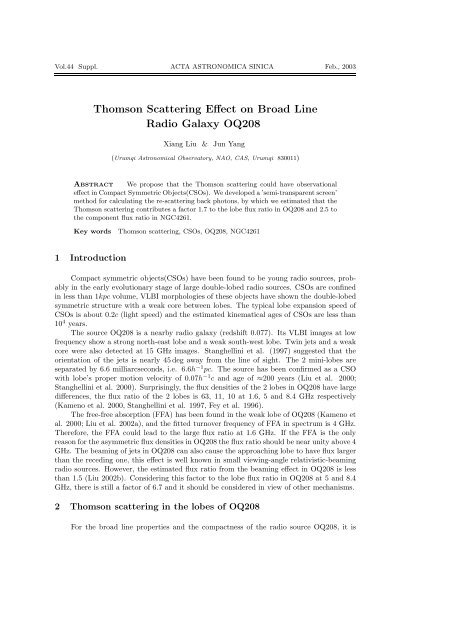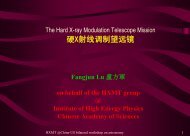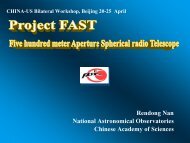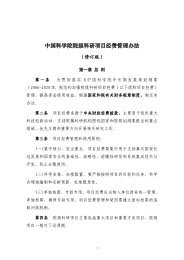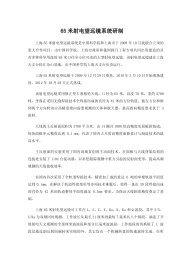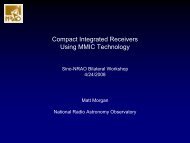Thomson Scattering Effect on Broad Line Radio Galaxy OQ208
Thomson Scattering Effect on Broad Line Radio Galaxy OQ208
Thomson Scattering Effect on Broad Line Radio Galaxy OQ208
You also want an ePaper? Increase the reach of your titles
YUMPU automatically turns print PDFs into web optimized ePapers that Google loves.
Vol.44 Suppl. ACTA ASTRONOMICA SINICA Feb., 2003<str<strong>on</strong>g>Thoms<strong>on</strong></str<strong>on</strong>g> <str<strong>on</strong>g>Scattering</str<strong>on</strong>g> <str<strong>on</strong>g>Effect</str<strong>on</strong>g> <strong>on</strong> <strong>Broad</strong> <strong>Line</strong><strong>Radio</strong> <strong>Galaxy</strong> <strong>OQ208</strong>Xiang Liu & Jun Yang(Urumqi Astr<strong>on</strong>omical Observatory, NAO, CAS, Urumqi 830011)ABSTRACT We propose that the <str<strong>on</strong>g>Thoms<strong>on</strong></str<strong>on</strong>g> scattering could have observati<strong>on</strong>aleffect in Compact Symmetric Objects(CSOs). We developed a ’semi-transparent screen’method for calculating the re-scattering back phot<strong>on</strong>s, by which we estimated that the<str<strong>on</strong>g>Thoms<strong>on</strong></str<strong>on</strong>g> scattering c<strong>on</strong>tributes a factor 1.7 to the lobe flux ratio in <strong>OQ208</strong> and 2.5 tothe comp<strong>on</strong>ent flux ratio in NGC4261.Key words<str<strong>on</strong>g>Thoms<strong>on</strong></str<strong>on</strong>g> scattering, CSOs, <strong>OQ208</strong>, NGC42611 Introducti<strong>on</strong>Compact symmetric objects(CSOs) have been found to be young radio sources, probablyin the early evoluti<strong>on</strong>ary stage of large double-lobed radio sources. CSOs are c<strong>on</strong>finedin less than 1kpc volume, VLBI morphologies of these objects have shown the double-lobedsymmetric structure with a weak core between lobes. The typical lobe expansi<strong>on</strong> speed ofCSOs is about 0.2c (light speed) and the estimated kinematical ages of CSOs are less than10 4 years.The source <strong>OQ208</strong> is a nearby radio galaxy (redshift 0.077). Its VLBI images at lowfrequency show a str<strong>on</strong>g north-east lobe and a weak south-west lobe. Twin jets and a weakcore were also detected at 15 GHz images. Stanghellini et al. (1997) suggested that theorientati<strong>on</strong> of the jets is nearly 45 deg away from the line of sight. The 2 mini-lobes areseparated by 6.6 milliarcsec<strong>on</strong>ds, i.e. 6.6h −1 pc. The source has been c<strong>on</strong>firmed as a CSOwith lobe’s proper moti<strong>on</strong> velocity of 0.07h −1 c and age of ≈200 years (Liu et al. 2000;Stanghellini et al. 2000). Surprisingly, the flux densities of the 2 lobes in <strong>OQ208</strong> have largedifferences, the flux ratio of the 2 lobes is 63, 11, 10 at 1.6, 5 and 8.4 GHz respectively(Kameno et al. 2000, Stanghellini et al. 1997, Fey et al. 1996).The free-free absorpti<strong>on</strong> (FFA) has been found in the weak lobe of <strong>OQ208</strong> (Kameno etal. 2000; Liu et al. 2002a), and the fitted turnover frequency of FFA in spectrum is 4 GHz.Therefore, the FFA could lead to the large flux ratio at 1.6 GHz. If the FFA is the <strong>on</strong>lyreas<strong>on</strong> for the asymmetric flux densities in <strong>OQ208</strong> the flux ratio should be near unity above 4GHz. The beaming of jets in <strong>OQ208</strong> can also cause the approaching lobe to have flux largerthan the receding <strong>on</strong>e, this effect is well known in small viewing-angle relativistic-beamingradio sources. However, the estimated flux ratio from the beaming effect in <strong>OQ208</strong> is lessthan 1.5 (Liu 2002b). C<strong>on</strong>sidering this factor to the lobe flux ratio in <strong>OQ208</strong> at 5 and 8.4GHz, there is still a factor of 6.7 and it should be c<strong>on</strong>sidered in view of other mechanisms.2 <str<strong>on</strong>g>Thoms<strong>on</strong></str<strong>on</strong>g> scattering in the lobes of <strong>OQ208</strong>For the broad line properties and the compactness of the radio source <strong>OQ208</strong>, it is
¦ £suppl. X. Liu & J. Yang: <str<strong>on</strong>g>Thoms<strong>on</strong></str<strong>on</strong>g> <str<strong>on</strong>g>Scattering</str<strong>on</strong>g> <str<strong>on</strong>g>Effect</str<strong>on</strong>g> <strong>on</strong> <strong>Broad</strong> <strong>Line</strong> <strong>Radio</strong> <strong>Galaxy</strong> <strong>OQ208</strong> 297possible that <str<strong>on</strong>g>Thoms<strong>on</strong></str<strong>on</strong>g> scattering could lead to an observati<strong>on</strong>al effect <strong>on</strong> the lobe flux ratioin <strong>OQ208</strong>.As the first approximati<strong>on</strong>, we assume that the lobe flux ratio 6.7 as menti<strong>on</strong>ed abovein <strong>OQ208</strong> is due to <str<strong>on</strong>g>Thoms<strong>on</strong></str<strong>on</strong>g> scattering. As a result the mean medium density between lobescould be obtained; then the <str<strong>on</strong>g>Thoms<strong>on</strong></str<strong>on</strong>g> scattering can be calculated in detail by accountingfor the re-scattering back phot<strong>on</strong>s, such that a more realistic lobe flux ratio caused by the<str<strong>on</strong>g>Thoms<strong>on</strong></str<strong>on</strong>g> scattering can be obtained.For the distance between the 2 lobes in <strong>OQ208</strong> al<strong>on</strong>g the line of sight, ∆l = 6.6h −1 pc(we use h = 0.75); the flux ratio of lobes I a /I r = 6.7, and the <str<strong>on</strong>g>Thoms<strong>on</strong></str<strong>on</strong>g> scattering secti<strong>on</strong>rate σ T = 6.65 × 10 −25 cm 2 , we have (see Fig.1)¥§¦¢¡θ¤£¨¨©Fig. 1 The <str<strong>on</strong>g>Thoms<strong>on</strong></str<strong>on</strong>g> scattering as the first approximati<strong>on</strong>Fig. 2 A diagram for the calculati<strong>on</strong> of the <str<strong>on</strong>g>Thoms<strong>on</strong></str<strong>on</strong>g>scattering in <strong>OQ208</strong>I a = I × exp(−σ T n 2 l 2 ) , (1)I r = I × exp[−σ T (n 1 ∆l + n 2 l 2 )] , (2)I a /I r = exp(σ T n 1 ∆l) . (3)The I is the intensity emitted by each lobe and we assume it is same for 2 lobes, thenthe mean medium density is n 1 = 1.1 × 10 5 cm −3 .Assuming that the medium density varies with r as (Fanti 2000) ρ = ρ 0 (r 0 /r) 2 , whenr > r 0 , ρ 0 (usually assumed as a c<strong>on</strong>stant) is the medium density inside r 0 . Using the n 1above, the producti<strong>on</strong> ρ 0 r0 2 can be determined. We integrate the column density from theweak lobe al<strong>on</strong>g the line of sight to the point ’a’ in Fig.2 where a half flux from the weaklobe is just scattered,∫ θln 0.5 = −σ T ρdl , (4)i.e. θ = 13.6 deg from the horiz<strong>on</strong> line in Fig.2. A equivalent ‘half transparent screen’scattering the half phot<strong>on</strong>s could be estimated as< l >=∫ 13.645lρdl/45∫ 13.645ρdl = 0.418L , (5)0.418L is at θ = 30.2 deg from the horiz<strong>on</strong> line in Fig.2, is marked as ‘1’. The scatteredphot<strong>on</strong>s will be partly re-scattering back. As above we integrate from the screen ‘1’ up to
298 ACTA ASTRONOMICA SINICA Vol.44the point where a half of the scattered <strong>on</strong>es will be reflected back, it is at θ = 61.6 deg; withequati<strong>on</strong> (5) the equivalent ‘half transparent screen’ is at θ = 47.5 deg, is marked as ‘2’, nearthe weak lobe.Through the serial ‘half-transparent screen’ before point ‘a’, by a complete analysis andcalculati<strong>on</strong> we finally obtained the sum of phot<strong>on</strong>s arriving at the point ‘a’ with respect tothe <strong>on</strong>es emitted (I) from the weak lobe is ≈ 0.80I.By the same approach we have the point ‘b’ where a half of the flux come from ‘a’is scattered, the θ at ‘b’ is -18 degree. Again follow this way, the point ‘c’ is the placethere a half of the flux from ’b’ is scattered. Finally the sum phot<strong>on</strong>s come out from ‘c’ is≈ 0.80×0.83×0.86I = 0.57I. The flux ratio for the approaching lobe to the receding lobe is≈ 1/0.59 = 1.7 assuming the mean medium density is 1.1 × 10 5 cm −3 in a few pc away fromthe center of <strong>OQ208</strong>, for the near broad line regi<strong>on</strong> of AGNs this medium density could bereas<strong>on</strong>able.For a more realistic example, the source NGC4261, the viewing angle of its jets is 63degree, the average medium density ≈ 1 × 10 6 cm −3 , and the separati<strong>on</strong> ≈ 0.5pc between2 bright comp<strong>on</strong>ents near its accreti<strong>on</strong> disk (J<strong>on</strong>es et al. 2000). We found the recedingcomp<strong>on</strong>ent can be dimmed by ≈ 40% through <str<strong>on</strong>g>Thoms<strong>on</strong></str<strong>on</strong>g> scattering, this can account fora part of the weakness of the receding jet in NGC4261, although free-free absorpti<strong>on</strong> wassuggested for the weakness by J<strong>on</strong>es et al.(2000).In summary, the beaming effect cannot fully account for the large flux ratio of lobesin near broad line regi<strong>on</strong> of CSOs, we propose that the <str<strong>on</strong>g>Thoms<strong>on</strong></str<strong>on</strong>g> scattering could causeobservati<strong>on</strong>al effect in these compact sources. We have developed a ‘semi-transparent screen’method for calculating the re-scattering back phot<strong>on</strong>s; we estimated that the <str<strong>on</strong>g>Thoms<strong>on</strong></str<strong>on</strong>g>scattering c<strong>on</strong>tributes a factor 1.7 to the lobe flux ratio in <strong>OQ208</strong>, and 2.5 to the comp<strong>on</strong>entflux ratio in NGC4261.ACKNOWLEDGEMENTS L.X. thanks Prof. Jiang D<strong>on</strong>gr<strong>on</strong>g and Dr. Cao Xinwu forvaluable discussi<strong>on</strong>s, and Dr. Wang Weihua for help <strong>on</strong> the paper. This work is supportedby the Nati<strong>on</strong>al Natural Science Foundati<strong>on</strong> of China (19970314).ReferencesFanti C., in the Proceedings of the 5th European VLBI Network Symposium, In: C<strong>on</strong>way J.E., et al. eds.,published by Onsala Space Observatory, Chalmers Technical University, 2000Fey A.L., Clegg A.W., Fomal<strong>on</strong>t E.B., ApJS, 1996, 105, 299Kameno S., Horiuchi S., Shen Z.-Q., et al., PASJ, 2000, 52, 209J<strong>on</strong>es D.L., Wehrle, A.E., Meier, D.L., et al., ApJ, 2000,534, 165Liu Xiang, Stanghellini C., Dallacasa D., et al., Chin. Phys. Lett., 2000, 17(4), 307Liu Xiang, Stanghellini C., Dallacasa D., et al., A&A, 2002a, 385, 768Liu Xiang, PhD thesis, 2002bStanghellini C., B<strong>on</strong>di M., Dallacasa D., et al., A&A, 1997, 318, 376Stanghellini C., Dallacasa D., B<strong>on</strong>di M., et al., in the Proceedings of the 5th European VLBI Network Symposium,In: C<strong>on</strong>way J.E., ed., published by Onsala Space Observatory, Chalmers Technical University,2000


